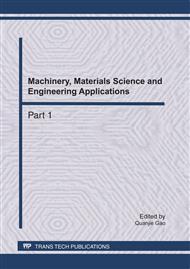p.681
p.686
p.692
p.696
p.702
p.708
p.714
p.719
p.723
Research on Low-Pressure Common Rail Electrical Control Injection System of Dimethyl Ether Engine
Abstract:
According to such properties of DME as high saturated vapor pressure, low viscosity and easy formation of mixture with air, a CPC (Controllable Premix Combustion) low-pressure common rail electrical control fuel injection test bench of DME engine is developed through this research. In addition, an overall design of the test system, hardware and software development of electrical control unit (ECU) and a test on the test bench are undertaken. The software of ECU is programmed by using real time modular programming. It has the advantages of flexible programming, convenient transplantation and wide extending possibility. Test results show that the injector switch timely, spray powerfully and pulverize perfectly. The software accomplishes many tasks such as signal acquisition as well as real-time control requirement of engine operation. Test result also shows the feasibility and good comprehensive performance of low-pressure common rail electronic system for DME fuel.
Info:
Periodical:
Pages:
702-707
Citation:
Online since:
April 2011
Authors:
Price:
Сopyright:
© 2011 Trans Tech Publications Ltd. All Rights Reserved
Share:
Citation:


